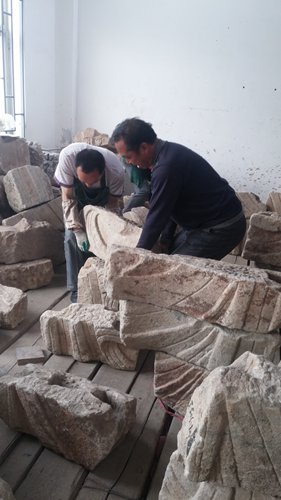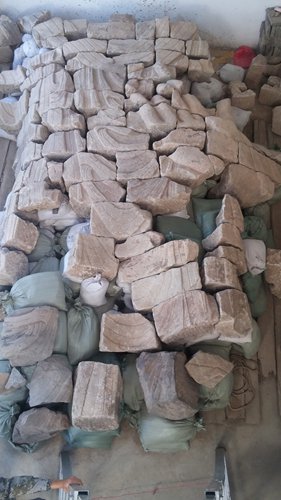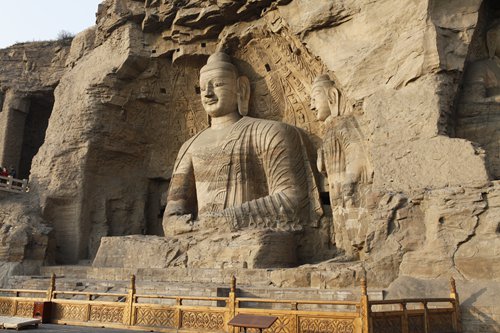Information
Experts at the Yungang Grottoes spend three years reassembling giant Buddha statue

Experts carry pieces of the West Standing Buddha. Photo: Courtesy of Yungang Grottoes Research Institute

The recovered parts of the West Standing Buddha Photo: Courtesy of Yungang Grottoes Research Institute

The Lutian Buddha and the East Standing Buddha (right) in the No.20 Yungang Grottoes Photo: Courtesy of Yungang Grottoes Research Institute
A portion of a 9.5-meter Buddha statue broken into more than 130 pieces and buried underground for over 1,600 years has been reassembled recently, thanks to the painstaking efforts of experts to reassemble it by hand.
"To avoid damaging the relic, we chose to not use machines, such as cranes, to help move the pieces during the reassembly process," Yuan Xiaozhong, head of the project and associate director of the Yungang Grottoes' Archaeology and Cultural Relics Department, told the Global Times on Wednesday.
While some of the pieces weighed as much as 100 kilograms, "we still chose to move them by hand. Sometimes it took two to three people working together to move just one," Yuan said.
Mysterious past
The Buddha statue in question, known as the West Standing Buddha, was originally located in the No.20 grotto of the renowned Yungang Grottoes in North China's Shanxi Province, along with the grottoes' famous 13.7-meter sitting Lutian Buddha statue and the smaller East Standing Buddha.
Unfortunately, the West Standing Buddha disappeared some time during the Northern Wei Dynasty (386-534) when people first started building inside the grottoes, leaving only the portions of its body below the knees remaining.
Experts do not know why the statue was removed. Some believe it may have collapsed, while others theorize it was taken down because it was about to collapse.
"The reason for the collapse, if that's what happened, is still unknown," Yuan explained. "It could have been due to an unstable foundation underneath the statue, the impact of an earthquake, or even human error, such as a careless stroke by a craftsman working at the grottoes."
For centuries no one knew where the statue had gone, until 1940 when Japanese scholars discovered some pieces of the statue buried nearby.
In 1992 more pieces were discovered. Experts determined that these pieces belonged to the statue's central body.
A closer examination of these pieces revealed that they had been deliberately cut up into some more than 130 pieces.
The team discovered that the separation of the statue wasn't random, so the cutters clearly did not intend to destroy the statue. The upper parts of the Buddha's body were cut into smaller pieces, while the lower half was cut into bigger pieces. They also avoided breaking the pattern of the Buddha's clothing while dividing the statue into its separate pieces.
To date the head and the right arm of the statue remain missing.
Arduous task
Even though the pieces were well-preserved when the more of them were discovered in 1992, restoration efforts didn't start until 2014.
"When we finally found the rest of them in the early 1990s, we kept them in our warehouse for two decades due to the complexity and the huge scale of the restoration - we didn't have the resources needed to do that then."
According to Yuan, difficulties reassembling the statue mainly come down to two issues: lack of relevant historical records and the daunting task of carrying out the restoration by hand with limited technological assistance.
"There are barely any records in the histories of the Northern Wei about the establishment of the grottoes, let alone about this statue in particular," Yuan said.
"Fortunately, we can use the better-preserved East Standing Buddha for reference since the two statues are wearing clothes with the same patterns. However, they still have different hand gestures."
Not just a jigsaw puzzle
While matching the different pieces together may sound like nothing more than a enormous jigsaw puzzle, it is actually much more complicated.
Before the team could begin, they had to sketch every broken piece, number them and then group them together.
"We used 3D scanning," Yuan told the Global Times, "But we later found that automatic assembly by computer was inaccurate, as such the scans could only serve as references.
"We drew up several plans, but finally decided the best way to carry things out was by hand."
After all the preparation work was completed, the team continued to take more photos and try to match pieces together based on the surface patterns and coloring on the stones.
"As this is a first for the Yungang Grottoes, this project, as far as I know, is the most challenging project of its kind in the country," Yuan said.
Currently, while the team has finished matching the pieces, experts are still working on ways to glue the pieces together so the statue may stand on its feet once again one day.
But considering the unstable rock foundation at the No.20 grotto, Yuan said the renovated statue will not be put back in its original place, but instead placed in a hall to the south of the grotto. How long this will take, however, is currently unknown.
Category: English
News
Information
Key words:
